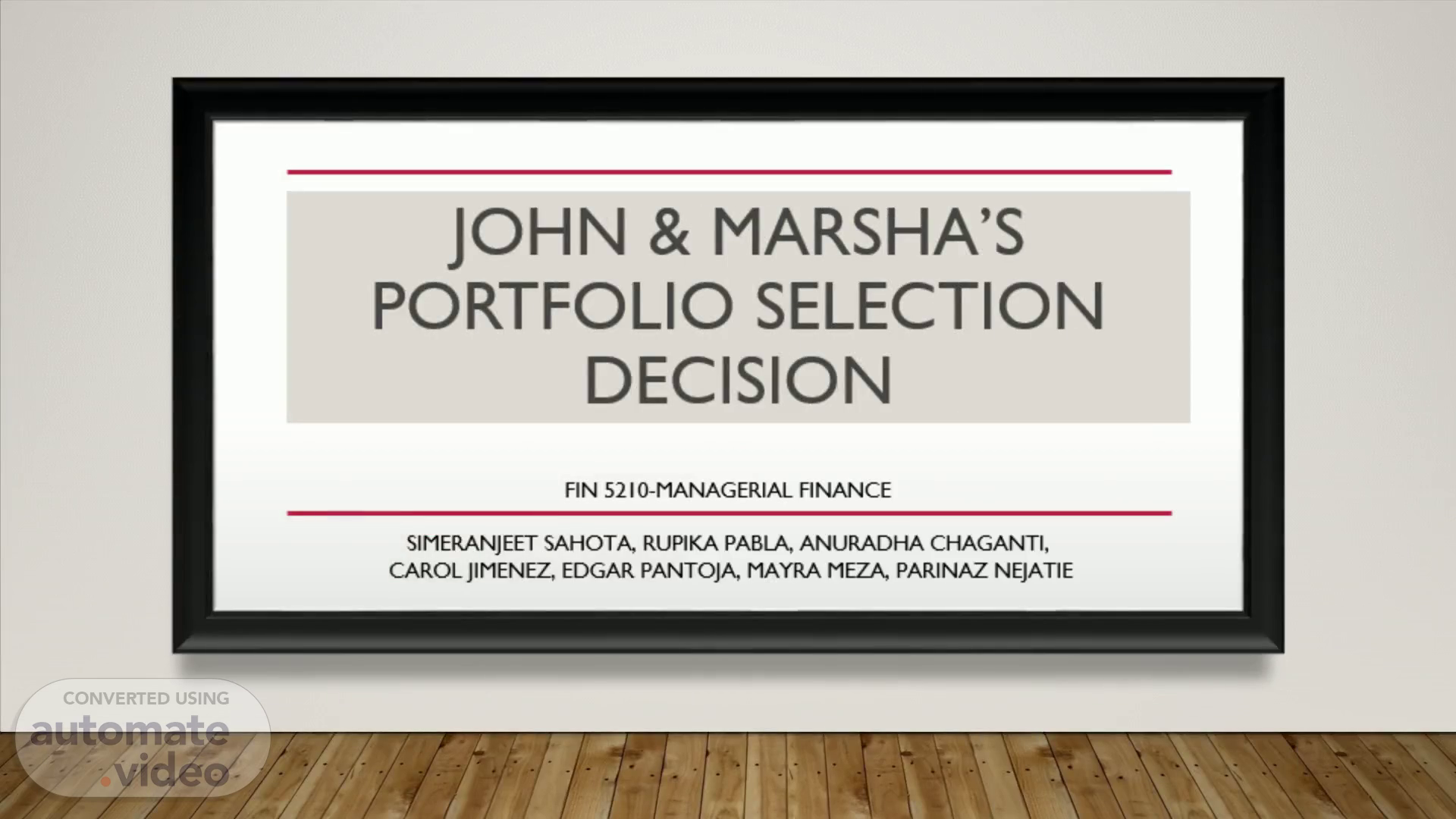
John & Marsha's Portfolio Selection Decision
Scene 1 (0s)
John & Marsha’s Portfolio Selection Decision. FIN 5210-Managerial Finance Simeranjeet Sahota, Rupika Pabla , Anuradha Chaganti , Carol Jimenez, Edgar Pantoja, Mayra Meza, Parinaz Nejatie.
Scene 2 (12s)
The Problem. Marsha has proposed to John (a security analyst), but he has a secret he wants to get out into the open before he accepts. He reveals that he is hopelessly in love with indexing! Marsha takes this news in stride. They will try to get over this obstacle together! Indexing is a passive method of investing stocks by creating specialized portfolios. John has dabbled in indexing for many years, getting an average of 90% return over time. He often looks for highly under- or overvalued stocks to take advantage of. Currently he has his sights on two stocks, Pioneer Gypsum and Global Mining. In this case study, we will try to help John overcome his uncertainty about these two stocks so this couple will have their “happily ever after”!.
Scene 3 (1m 11s)
The Facts. To the right are John’s notes on Pioneer Gypsum and Global Mining. We will help him to calculate the following: expected return risk premium standard deviation of a portfolio invested partly in the market and partly in Pioneer. We will also answer the following questions: does adding Pioneer to the market benchmark improve the Sharpe ratio? How much should John invest in Pioneer and how much in the market?.
Scene 4 (4m 14s)
More Facts. In this case, one thing John did not mention is what the standard deviation of the S&P was. The beta of a stock is the ratio of the covariance of the stock with market return to the variance of the market. The market standard deviation was given as 0.16. Variance is 0.0256 (that is, the square root of standard deviation 0.16). Covariance for Pioneer Gypsum: Beta = Covariance of Pioneer Gypsum with market return/ Variance of Market 0.65 = Covariance of Pioneer Gypsum with market return/0.0256 Covariance of Pioneer Gypsum with market = 0.0256 * 0.65 Therefore, covariance of Pioneer Gypsum with market return = 0.01664.
Scene 5 (5m 10s)
Expected Return on Portfolio - Pioneer. Assume if investment stock of PG is 1% and market is 99%. Therefore: Expected return on portfolio = (proportion of stock 1 * expected return stock 1) + (proportion of stock 2 * expected return stock 2) = (0.01 * 11%) + (0.99 * 12.5%) = 0.11% + 12.375% = 12.485% Risk premium = Expected return on portfolio - Risk-free rate = 12.485% - 5% = 7.485%.
Scene 6 (5m 57s)
Standard Deviation and SharPe ratio - Pioneer. Assume PG is 1% and market is 99%: Standard deviation = √(0.01² x 0.32²) + (0.99² x 0.16²) + (2 x 0.01 x 0.99 x 0.16 x0.32 x 0.01664) = √(0.00001024) + (0.02509056) + (0.00001687) = √0.02511767 = 0.1585 Next, calculate the Sharpe ratio = (Rm-Rf) / Portfolio = (0.12485 - 0.05) / 0.1585 = 0.075 / 0.1585 = 0.4722.
Scene 7 (7m 58s)
Calculation – Pioneer Gypsum. S&P 500 Pioneer S&P 500 .0256 .01664 Pioneer .01664 .1024.
Scene 8 (8m 46s)
Spreadsheet Calculations. Table Description automatically generated.
Scene 9 (9m 7s)
Expected Return on Portfolio – Global Mining. Now we will repeat the analysis for Global Mining. Assume that Global accounts for 0.75% of the S&P index. Beta = Covariance of Global Mining with market return/ Variance of Market 1.22 = Covariance of Global Mining with market return/ 0.0576 Covariance of Global Mining with market = 1.22 * 0.0576 Covariance of Global Mining with market = 0.07027 Assume if investment stock of GM is 1% and market is 99% Expected return on portfolio = (proportion of stock 1 * expected return stock 1) + (proportion of stock 2 * expected return stock 2) = (0.01 * 12.9%) + (0.99 * 12.5%) = 0.12% + 12.38% = 12.50%.
Scene 10 (10m 41s)
Standard Deviation and SharPe ratio – Global Mining.
Scene 11 (14m 16s)
Calculation – Global mining. S&P 500 Global S&P 500 .0256 .03123 Global .3123 .0576.
Scene 12 (15m 19s)
Calculations. We need to calculate the portfolio return, portfolio standard deviation, and the Sharpe ratio for all the fractions in the market and Pioneer. If John’s portfolio matches the market and includes 0.75%, then he needs to sell his Global shares and put it back into the market..
Scene 13 (17m 10s)
Calculations (continued). S&P 500 Global Sharpe ratio 0.99 0.01 0.4673 1 0 0.4688 1.005 -0.005 0.4695 1.0075 -.0075 0.4699.
Scene 14 (17m 57s)
Conclusion. Question 1: Does adding Pioneer to the market benchmark improve the Sharpe ratio? Yes, adding Pioneer to the market bench increases the Sharpe ratio. The Sharpe ratio is highest when the expected return is 11% invested in Pioneer Gypsum stock. The investment should be 16% in Pioneer and 84% in market. Question 2: Repeat analysis for Global Mining. What should John do in this case? Assume that Global accounts for 0.75% of the S&P Index. The calculations for Global shows that this investment is not advisable since John would be “selling short”. Since we don’t have enough evidence whether John would have permission to proceed with such a decision, he should decline to move forward with the investment..